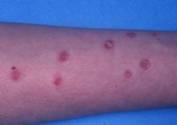 Rats can be really interesting pets. They can be quite social and are interesting to watch. Being larger than hamsters and gerbils, they can also be more easily and safely handled. They can still bite, however, particularly if they are not properly socialized and/or they are handled by people who don’t know how to do
Rats can be really interesting pets. They can be quite social and are interesting to watch. Being larger than hamsters and gerbils, they can also be more easily and safely handled. They can still bite, however, particularly if they are not properly socialized and/or they are handled by people who don’t know how to do
Pocket pets
Testing for ringworm with toothbrushes
If your veterinarian suspects your pet may have ringworm, there are several different ways he or she may test for the causative fungus (a dermatophyte) on your animal’s fur and skin. Some of these techniques are more useful than others in different situations.
- Wood’s lamp: A Wood’s lamp is simply a special ultraviolet
…
Nontraditional Pets and Children: Beware
 A report about the health risks in children associated with nontraditional pets was recently published in Pediatrics, the official journal of the American Academy of Pediatrics. The report also discusses diseases associated with animals in public settings such as petting zoos and pet stores. Although contact with pets and animals can be beneficial…
A report about the health risks in children associated with nontraditional pets was recently published in Pediatrics, the official journal of the American Academy of Pediatrics. The report also discusses diseases associated with animals in public settings such as petting zoos and pet stores. Although contact with pets and animals can be beneficial…
Ringworm Part 2: Cleaning Up
 For more information on ringworm, see the Worms & Germs post Ringworm: Skin fungus by any other name. The photos here show ringworm lesions on a person’s arm and on a cat’s face, respectively. (Photo credits: A. Yu, Ontario Veterinary College)
For more information on ringworm, see the Worms & Germs post Ringworm: Skin fungus by any other name. The photos here show ringworm lesions on a person’s arm and on a cat’s face, respectively. (Photo credits: A. Yu, Ontario Veterinary College)
 Over the past several years, studies have shown that many environmental disinfectants sold…
Over the past several years, studies have shown that many environmental disinfectants sold…
Ringworm: skin fungus by any other name
Ringworm infection is not caused by a worm at all – it’s actually a skin infection caused by certain kinds of fungus called dermatophytes. The scientific name for ringworm is dermatophytosis, or dermatomycosis. Some of the more common zoonotic species of dermatophytes found in animals include Microsporum canis, Trichophyton verrucosum, T. equinum, and T…
Your mother was right! Wash your hands
 You may notice a recurring theme in many of our posts and on virtually all of the information sheets on the Worms & Germs Resources page: an emphasis on handwashing. There is increasing emphasis on hand hygiene (i.e. hand washing and use of alcohol hand sanitizers) education in hospitals because the hands of healthcare…
You may notice a recurring theme in many of our posts and on virtually all of the information sheets on the Worms & Germs Resources page: an emphasis on handwashing. There is increasing emphasis on hand hygiene (i.e. hand washing and use of alcohol hand sanitizers) education in hospitals because the hands of healthcare…
Happy Household Hamsters
The right kind of pet can be an invaluable source of learning experiences for a child. But there’s always the question of what is the right kind of pet for a child, a family and a household? A dog or a cat is not ideal for everyone. Sometimes a small pet, such as a hamster,…
Exposure to animal blood
Periodically, pet owners may be exposed to blood from a pet. This can range from exposure to small amounts of blood through minor injuries like cut foot pads or broken toenails, to large amounts of blood following severe trauma.
 In people, there are detailed protocols for avoiding blood exposure in healthcare situations, and protocols…
In people, there are detailed protocols for avoiding blood exposure in healthcare situations, and protocols…
Hazardous hedgehogs
While most people that want a pet stick to the tried-and-true species, there are a huge number of different animals available. Some make good pets, some are relatively harmless but not suitable for most households and some are potentially dangerous. Hedgehogs probably fit into the latter 2 categories.
No…hedgehogs aren’t sneaking out of their cages…
Pet store sued after hamster-associated death
A woman whose husband died of lymphocytic choriomeningitis virus (LCMV) infection is suing a pet store. The suit alleges that a hamster purchased at the store was the source of infection of a person, who subsequently suffered a fatal stroke (unrelated to the infection). The hamster-owner’s liver was donated to the Plaintiff’s husband, who…